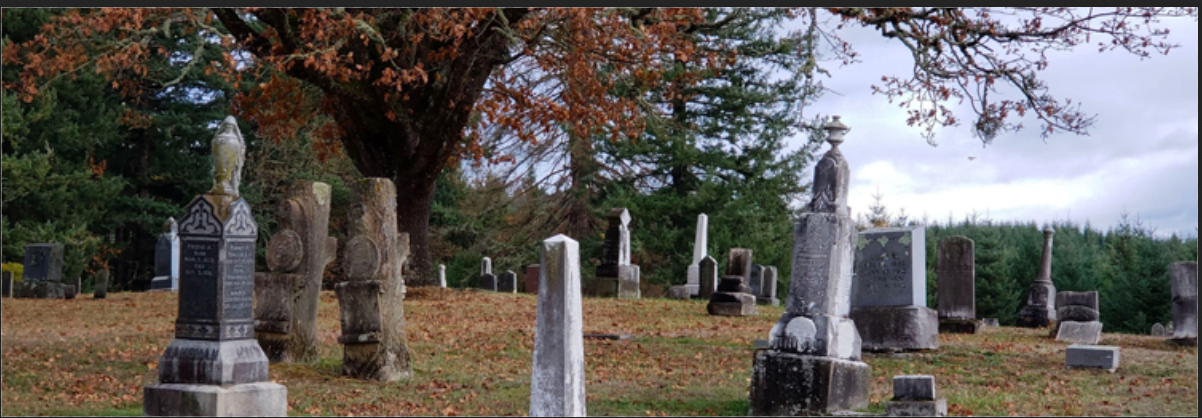Every summer, my family used to trek across the US in our second-hand mini-van and visit my grandmother on the Oregon coast. I was already a morbid child by that point, and while my family could have found it creepy and unsettling with my interest in ghost stories and death, instead they encouraged me to channel it into healthy avenues. This blog, itself, is probably one of those avenues nowadays. In my teen years, it was gravestone rubbing. You may already be aware of the hobby, where you place a large piece of paper over a gravestone and rub it gently with charcoal to create an imprint of the masonry. In Oregon in the early 2000s, it was common to see me walking from my grandmother’s historic house on the hill to the cemetery just a few blocks away.

The gravestones had seen better days and there was very little groundwork done on the old cemetery. As I explored, I found some of the oldest graves were from the 1850s, and there were waves of deaths in the same year showing the community being devastated by one disease or another. I read and rubbed gravestones with tragic stories and others with loving final messages after a long life well lived. My love with cemeteries began with that hobby and has not abated since.

Cemeteries in Oregon hold a special place in my heart, and one cemetery might just have the most ghost stories of any other in the state, simply due to its proximity to the University of Oregon’s campus. Many students tell stories of the cemetery and the haunting things that happen there after dark. Today we’re exploring the Eugene Pioneer Cemetery, just an hour or so away from the Gardiner Cemetery that I loved so much as an adolescent. With stories detailing the activity that occurred at the cemetery, statues moving on their own, and helpful spirits looking after people who wander within the gates after dark.
The Eugene Pioneer Cemetery was first established in 1872, with the burial of several pioneers who trekked across the country in covered wagons on the Oregon trail. Obviously the name Pioneer resonates with those familiar with the cemetery, its history being tied to the town of Eugene itself and the development of the town over the centuries. More than 4000 souls are buried in the cemetery, some more famous than others, but the proximity to the campus of the University of Oregon gives life to more legends and sightings of ghostly happenings within the iron gates.

A specific historic part of the cemetery is still a popular place for reflection and reverence. The Grand Army of the Republic plot, also known as the GAR, holds the graves of 57 veterans, their families, and soldiers from as far back as the Civil War. In the center of the plot stands a twenty-five-foot statue of a Union soldier. Upon his death in 1903, Union veteran John Covell specified in his will that his estate should be used to purchase and place the giant statue, which was carved in Vermont and sent by railway to the then sleepy town of Eugene near the Oregon Coast.
Stories abound about the cemetery and its hauntings. The first involves this very statue coming to life and moving at night, keeping a vigilant watch on the bars of iron around the burial ground. Still more statues are also said to come to life, with University of Oregon students reporting to see flashes of marble moving in the cemetery after dark. All of the activity seems to happen after the sun goes down. Other reports say that multiple ghostly women wearing white have been seen patrolling the cemetery, taking careful care of the headstones and statues throughout, as if they stood vigil for the lost souls buried 6-feet-deep.

The most common report of the cemetery is the ghostly sound of bagpipes being played in the darkness. Some students have even heard the haunting music carrying over the gravestones while taking a shortcut to class at dusk. Sometimes the music reaches the University campus, but when curious students investigate, there is no earthly source of the music, bagpipes have never been found in the cemetery, even if there were a living musician. Some claim to have seen the bagpipe player, dressed in full Scottish regalia, and watched him disappear into the night in front of their eyes.
The best time to catch spooky activity, legends say, is when the church across the street’s bells go off to signify 10:00 pm has arrived. Students sometimes gather when the bell rings, hoping that the spirits will make an appearance during the signal that night has arrived. A few professors on the campus have even commented on the hauntings, with one expert asserting that the stories told by students give the cemetery a positive aspect, calling them “The Good Dead,” rather than the Evil Dead. It seems the spirits in the Eugene Pioneer Cemetery are happy with their lot in the afterlife and don’t seek to do harm to any visitor, student or otherwise. The happy spirits may even enjoy spooking the college students from time to time.
Just watch out for the 25-foot soldier if his statue comes to life.
- About the Author
- Latest Posts

Born in Death Valley and raised on the prairie, Deborah is a Wyoming-based paranormal researcher and University of Wyoming graduate. Her interests lie in folklore, history, symbolic interaction and research. She also researches the paranormal academically and is a graduate student studying sociology.


